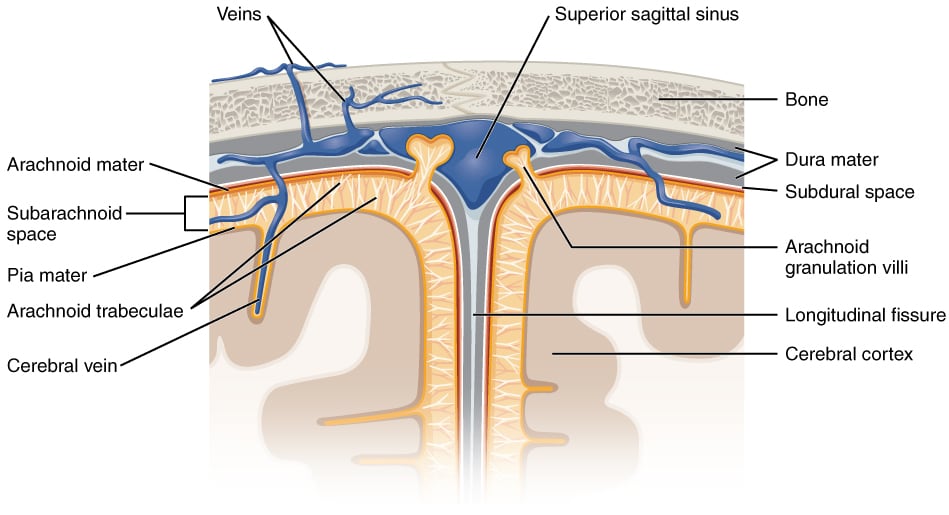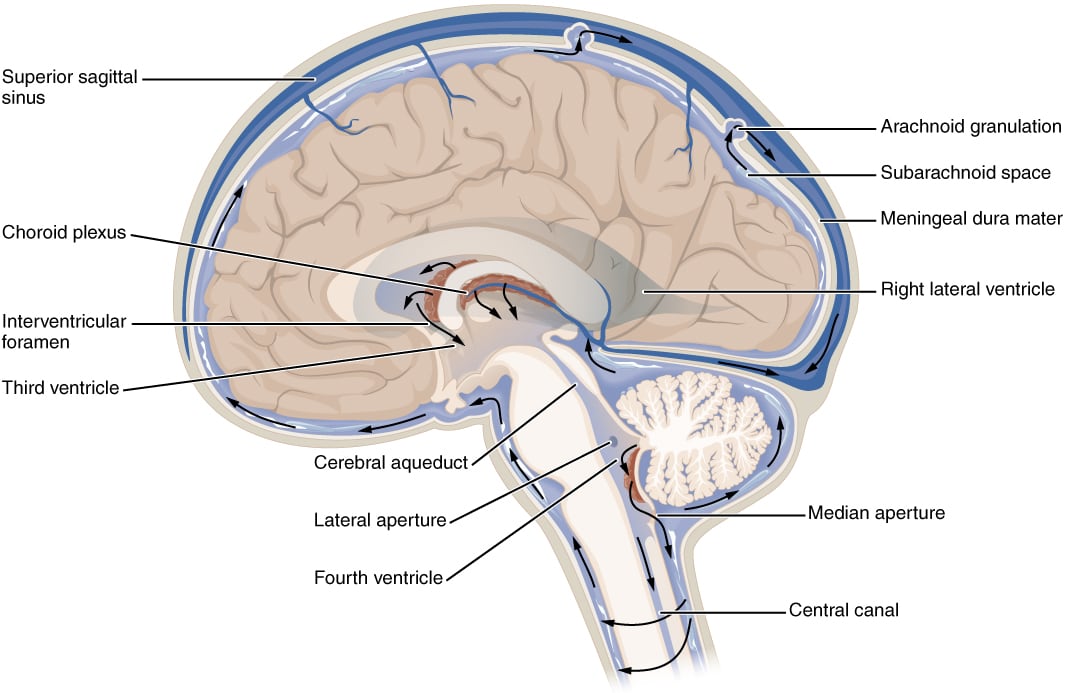The meninges consist of the innermost pia mater, middle arachnoid mater, and outer dura mater. The pia and arachnoid together are called leptomeninges. The dura is called pachymeninx. The pia is attached tightly to the brain and follows the grooves and sulci. Under the arachnoid mater is the subarachnoid space, which contains CSF. Meningeal nociceptors are located in the dura mater, and they detect the sensation of pain in headaches and meningeal irritation.
CSF is produced by the choroid plexuses mainly and in part by the ependymal cells. It circulates in the subarachnoid space and ventricles of the brain. About 150 ml of CSF is present in the ventricles at any time, continuously generated and reabsorbed. Reabsorption occurs at the arachnoid granulations. The cells of the choroid plexus are joined together by tight junctions forming the blood-CSF barrier. CSF is essentially an ultrafiltrate of plasma, having a higher concentration of sodium, chloride, and magnesium but lower levels of potassium and calcium than plasma. It acts as a cushion, protecting the soft brain against injury from the hard skull surrounding it. It also helps remove waste and maintain homeostasis in the brain.

The brain has 4 ventricles: two lateral ventricles, each in the cerebral hemispheres, one-third ventricle, and one-fourth ventricle. The lateral ventricles communicate with the third ventricle through the interventricular foramina. The third ventricle is present in the diencephalon. The cerebral aqueduct of Sylvius is located in the midbrain and connects the third ventricle to the fourth ventricle. The fourth ventricle is diamond-shaped, located posterior to the pons and upper medulla and anterior to the cerebellum. It connects to the subarachnoid space via two lateral foramina of Luschka and a median foramen of Magendie. The CSF flows from both lateral ventricles, interventricular foramina to the third ventricle, then from the aqueduct of Sylvius to the fourth ventricle, through the median foramen of Magendie and lateral foramina of Luschka to the subarachnoid space and gets distributed over the surface of the brain and spinal cord.

It comprises the caudate nucleus, putamen, globus pallidus, subthalamic nucleus, and substantia nigra. The putamen and caudate nucleus together are called striatum or neostriatum. The putamen and globus pallidus together form the lentiform or lenticular nuclei. The main function of the basal nuclei is motor control, followed by effects on cognition and eye movements.
The caudate nucleus is a C-shaped structure closely associated with the lateral wall of the lateral ventricle. The anterior limb of the internal capsule separates it from the putamen. The globus pallidus is divided into a medial internal segment and a lateral external segment. The subthalamic nucleus is located under the thalamus. The substantia nigra is a midbrain structure composed of two distinct parts: the pars compacta and pars reticulata. The pars compacta is the source of a clinically important dopaminergic pathway to the striatum, and the loss of neurons in this area is the cause of Parkinson’s disease. An area that is functionally analogous to the substantia nigra pars compacta is the ventral tegmental area, which is located nearby and makes a dopaminergic projection to the nucleus accumbens. Pars reticulata has GABA neurons.
The basal nuclei receive excitatory afferents from the cerebral cortex and thalamus - the frontal lobe projects to the head of the caudate nucleus and putamen, the temporal lobe to the tail of the caudate, while the parietal and occipital lobes project to the body of the caudate nucleus.
It includes the amygdala, hippocampus, fornix, mammillary bodies, cingulate gyrus, and parahippocampal gyrus. It is involved in memory and emotions.
The hippocampus is also called Ammon’s horn because it is shaped like two horns of a ram. It is located in the medial temporal lobe and is important for declarative memory, i.e., memory for facts and events, spatial memory, and the formation of new memories. The phenomenon of long-term potentiation is vital for memory formation in the hippocampus. The hippocampus is one of the earliest structures involved in Alzheimer’s disease. Hippocampal atrophy is seen in schizophrenia, PTSD, depression, and chronic stress. Pyramidal cells of the hippocampus have been implicated in temporal lobe epilepsy.
The amygdala is an almond-shaped group of neurons located deep in the medial temporal lobe and is involved in motivation, mediating the emotional aspects of memory, and in the processing of emotions like fear. The mammillary bodies are involved in spatial and episodic memory consolidation and storage (as part of the Papez circuit), recollective memory, emotion and reward behaviors, and goal-directed behaviors. Damage to the mammillary bodies from alcoholism and thiamine deficiency causes Wernicke- Korsakoff syndrome presenting with anterograde amnesia and confabulation.
It is the most important relay in the limbic system. It begins and ends at the hippocampus. From the hippocampus, signals are relayed via the fornix to the mammillary bodies and from there to the anterior nucleus of the thalamus via the mammillothalamic tract, from the thalamus fibres project to the cingulate gyrus and then back to the hippocampus.
Sign up for free to take 18 quiz questions on this topic